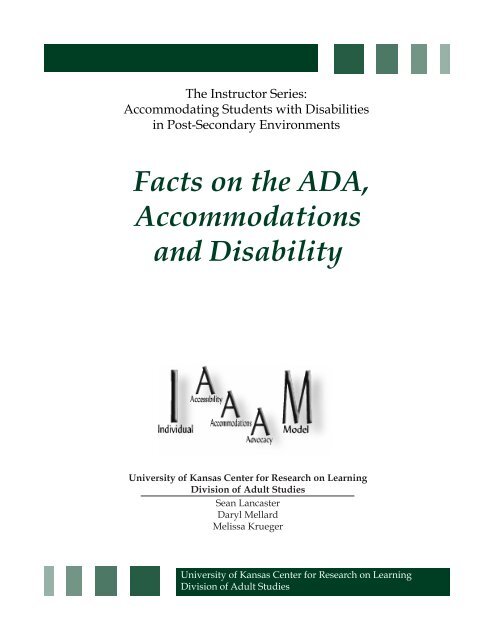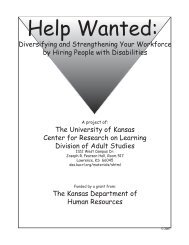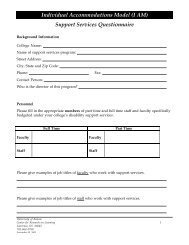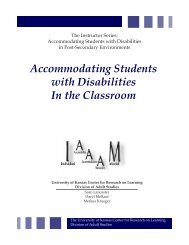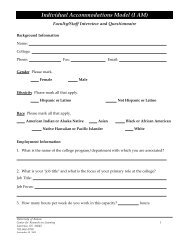Facts on the ADA Accommodations and Disability
Download PDF file - KU Center for Research on Learning
Download PDF file - KU Center for Research on Learning
You also want an ePaper? Increase the reach of your titles
YUMPU automatically turns print PDFs into web optimized ePapers that Google loves.
The Instructor Series:Accommodating Students with Disabilitiesin Post-Sec<strong>on</strong>dary Envir<strong>on</strong>ments<str<strong>on</strong>g>Facts</str<strong>on</strong>g> <strong>on</strong> <strong>the</strong> <strong>ADA</strong>,Accommodati<strong>on</strong>s<strong>and</strong> <strong>Disability</strong>University of Kansas Center for Research <strong>on</strong> LearningDivisi<strong>on</strong> of Adult StudiesSean LancasterDaryl MellardMelissa KruegerUniversity of Kansas Center for Research <strong>on</strong> LearningDivisi<strong>on</strong> of Adult Studies
The Instructor Series:Accommodating Students with Disabilitiesin Post-Sec<strong>on</strong>dary Envir<strong>on</strong>mentsThis booklet is part of a three-part series designed to help college faculty<strong>and</strong> instructors underst<strong>and</strong> <strong>the</strong>ir role in <strong>the</strong> educati<strong>on</strong>al accommodati<strong>on</strong>process. O<strong>the</strong>r booklets in this series include:• Accommodating Students with Disabilities in <strong>the</strong> Classroom• Accommodating for Disabilities Outside <strong>the</strong> ClassroomUniversity of Kansas, Center for Research <strong>on</strong> LearningDivisi<strong>on</strong> of Adult StudiesJoseph R. Pears<strong>on</strong> Hall1122 West Campus Rd., Room 521Lawrence, KS 66045-3101785.864.4780This document is available in alternate formats up<strong>on</strong> request. Please c<strong>on</strong>tact <strong>the</strong>Divisi<strong>on</strong> of Adult Studies for more informati<strong>on</strong>.Notice: This document was created using <strong>the</strong> definiti<strong>on</strong>s <strong>and</strong>regulati<strong>on</strong>s from <strong>the</strong> Americans with Disabilities Act of 1990. The<strong>ADA</strong> Amendments Act was passed in 2008 to address differentinterpretati<strong>on</strong>s of what c<strong>on</strong>stitutes a disability under <strong>the</strong> originalact, stressing a broad scope of protecti<strong>on</strong> under <strong>the</strong> law. See http://www.jan.wvu.edu/bulletins/adaaal.htm for more informati<strong>on</strong>.This document was supported in whole or in part by <strong>the</strong> U. S. Department of Educati<strong>on</strong>, Office of Special Educati<strong>on</strong> Programs,(Cooperative Agreement No. H324M980109). However, <strong>the</strong> opini<strong>on</strong>s expressed herein do not necessarily reflect <strong>the</strong> policy or positi<strong>on</strong>of <strong>the</strong> U. S. Department of Educati<strong>on</strong>, Office of Special Educati<strong>on</strong> Programs, <strong>and</strong> no official endorsement by <strong>the</strong> Department shouldbe inferred Note: There are no copyright restricti<strong>on</strong>s <strong>on</strong> this document: however, please credit <strong>the</strong> source <strong>and</strong> support of federal fundswhen copying all or part of this material. This document is also available <strong>on</strong> <strong>the</strong> web for printing at: http://das.kucrl.org/iam.html9/02
“I d<strong>on</strong>’t want to be classified asdisabled…I want to be included as anormal student.”A student with a head injuryAm I expected to become an expert <strong>on</strong>disabilities?No. The college has o<strong>the</strong>r staff wi<strong>the</strong>xpertise in verifying disabilities <strong>and</strong>determining academic accommodati<strong>on</strong>s.Many resources are available to assistfaculty <strong>and</strong> staff. The staff at <strong>the</strong> <strong>Disability</strong>Support Services office are willing <strong>and</strong> ableto work collaboratively with you in orderto ensure that all aspects of your collegeare inviting, welcoming <strong>and</strong> inclusive ofstudents with disabilities.Introducti<strong>on</strong> to <strong>the</strong> Americans withDisabilities ActThe Americans with Disabilities Act (<strong>ADA</strong>),l<strong>and</strong>mark civil rights legislati<strong>on</strong>, wasenacted in 1990. <strong>ADA</strong>’s purpose is toensure that people with disabilities aregranted equal access to employment, publicservices, places of publicaccommodati<strong>on</strong>, transportati<strong>on</strong>, <strong>and</strong>telecommunicati<strong>on</strong>s.Title II of <strong>the</strong> Americans withDisabilities Act prohibits discriminati<strong>on</strong>against people with disabilities by publicentities. These provisi<strong>on</strong>s includepublicly funded educati<strong>on</strong>al instituti<strong>on</strong>ssuch as universities, colleges, <strong>and</strong>technical schools. Privately fundededucati<strong>on</strong>al instituti<strong>on</strong>s are subject to similarn<strong>on</strong>-discriminati<strong>on</strong> requirements underTitle III of <strong>the</strong> Act <strong>and</strong> employers are coveredunder Title I.The prohibiti<strong>on</strong> against discriminati<strong>on</strong> isvery broad <strong>and</strong> encompasses all <strong>the</strong>programs, activities, <strong>and</strong> services that yourinstituti<strong>on</strong> provides.In general <strong>the</strong> Act requires…that people with disabilities have an equalopportunity to benefit from or participate inyour services.A major thrust of <strong>the</strong> <strong>ADA</strong> is to ensure thatpeople with disabilities gain access to <strong>the</strong>mainstream of American society. Accessto educati<strong>on</strong> is <strong>on</strong>e key toopening <strong>the</strong> doors of mainstream societyto people with disabilities.One way a college strives to ensure thatpeople with disabilities have equal accessis by providing accommodati<strong>on</strong>s forqualified people with disabilities.Accommodati<strong>on</strong>s are a necessary part ofmeeting <strong>the</strong> requirements of <strong>the</strong> <strong>ADA</strong>. Thecollege’s obligati<strong>on</strong> to provide accommodati<strong>on</strong>sextends to prospective <strong>and</strong> enrolledstudents, employees,members of <strong>the</strong> public who may wish toattend public events or activitiessp<strong>on</strong>sored by <strong>the</strong> college, <strong>and</strong> to any o<strong>the</strong>rindividual who is eligible to attend, enrollin or benefit from <strong>the</strong>college’s programs, services or activities.This bulletin will focus specifically <strong>on</strong>accommodati<strong>on</strong>s for students withdisabilities.Accommodati<strong>on</strong>s for StudentsAccommodati<strong>on</strong>s are a means of providingqualified students with disabilities a similaropportunity to benefit from <strong>the</strong>ir educati<strong>on</strong>alexperience as <strong>the</strong>ir n<strong>on</strong>-disabledcounterparts.<str<strong>on</strong>g>Facts</str<strong>on</strong>g> <strong>on</strong> <strong>ADA</strong>, Accommodati<strong>on</strong>s<strong>and</strong> <strong>Disability</strong>
The obligati<strong>on</strong> to provide accommodati<strong>on</strong>sfor students with disabilities is not a newc<strong>on</strong>cept. Most publicly funded educati<strong>on</strong>alinstituti<strong>on</strong>s have been subject to similarobligati<strong>on</strong>s for many years under <strong>the</strong>Rehabilitati<strong>on</strong> Act of 1973. Whe<strong>the</strong>r youhave been aware of it or not, your collegehas probably been providing some typeof accommodati<strong>on</strong>s for students withdisabilities for quite some time.During <strong>the</strong> 1995-96 academic year, six percentof first year students reported havinga disability that affected hearing, speech,mobility or visi<strong>on</strong>, but that number isincreasing. In fact, current reports suggestthat 1 out of 11 college students havereported that <strong>the</strong>y have a disability (U.S.Dept. of Educati<strong>on</strong>, 1999). Not every studentwith a disability will be eligible foror need an accommodati<strong>on</strong>. However,as more students with disabilities enrollin post-sec<strong>on</strong>dary educati<strong>on</strong>, <strong>the</strong> need foraccommodati<strong>on</strong>s will increase.• Changes to a classroom envir<strong>on</strong>mentor task that permit a student with adisability to participate in <strong>the</strong>educati<strong>on</strong>al process,• Removal of architectural barriers,Modificati<strong>on</strong>s to policies, practices orprocedures,• Provisi<strong>on</strong> of auxiliary aids <strong>and</strong>services, <strong>and</strong>• O<strong>the</strong>r adaptati<strong>on</strong>s or modificati<strong>on</strong>sthat enable a student to enjoy <strong>the</strong>benefits <strong>and</strong> privileges of <strong>the</strong> college’sprogram, services <strong>and</strong> activities.Accommodati<strong>on</strong>s do not lower academicst<strong>and</strong>ards or compromise <strong>the</strong>integrity of an academic program.Academic, c<strong>on</strong>duct <strong>and</strong> technicalst<strong>and</strong>ards will always be maintained.Accommodati<strong>on</strong>s are provided at no costfor eligible students. Eligibility for accommodati<strong>on</strong>sis discussed <strong>on</strong> page 6.What is an Accommodati<strong>on</strong>?An accommodati<strong>on</strong> is a legallym<strong>and</strong>ated modificati<strong>on</strong> or service that givesa student with a disability an equal opportunityto benefit from <strong>the</strong> educati<strong>on</strong>al process.It may be useful to think of accommodati<strong>on</strong>sasadjustments to how things are normallyd<strong>on</strong>e.The Accommodati<strong>on</strong>s ProcessTypically <strong>the</strong> accommodati<strong>on</strong> processstarts when a student c<strong>on</strong>tacts <strong>the</strong> DisabiitySupport Services (DSS) office or aninstructor <strong>and</strong> makes a request for adisability related accommodati<strong>on</strong>. If astudent asks you for an accommodati<strong>on</strong><strong>and</strong> has not had his or her disabilityverified by DSS you should refer <strong>the</strong>student to DSS.From <strong>on</strong>e perspective, accommodati<strong>on</strong>s canbe grouped into <strong>the</strong> followingcategories:<str<strong>on</strong>g>Facts</str<strong>on</strong>g> <strong>on</strong> <strong>ADA</strong>, Accommodati<strong>on</strong>s<strong>and</strong> <strong>Disability</strong>
Flow Chart of <strong>the</strong> Accommodati<strong>on</strong>s Process1Student makes c<strong>on</strong>tact with<strong>Disability</strong> Support Services<strong>and</strong> asks for accommodati<strong>on</strong>s.2Student may have to provide<strong>Disability</strong> Support Serviceswith recent, professi<strong>on</strong>al documentati<strong>on</strong>of disability.3<strong>Disability</strong> Support Services <strong>and</strong>student determine accommodati<strong>on</strong>s<strong>and</strong> instructor(s) will bec<strong>on</strong>sulted when necessary.4<strong>Disability</strong> Support Servicesprepares form or letter statingapproved accommodati<strong>on</strong>s.5Letter from <strong>Disability</strong> SupportServices is provided toinstructor.6Accommodati<strong>on</strong>s are provided.7ti<strong>on</strong>sStudent <strong>and</strong> <strong>Disability</strong> SupportServices evaluate accommodawithinput from instructor.<str<strong>on</strong>g>Facts</str<strong>on</strong>g> <strong>on</strong> <strong>ADA</strong>, Accommodati<strong>on</strong>s<strong>and</strong> <strong>Disability</strong>
Accommodati<strong>on</strong> Resp<strong>on</strong>sibilities<strong>Disability</strong> Student Services (DSS)StudentsInstructorPublicize how to requestaccommodati<strong>on</strong>sMaintain written procedures forh<strong>and</strong>ling accommodati<strong>on</strong>sVerify student’s disabilitiesImplement IndividualAccommodati<strong>on</strong>s Model inc<strong>on</strong>sultati<strong>on</strong> with student <strong>and</strong>instructorApprove accommodati<strong>on</strong>sLead role in arranging <strong>and</strong>providing accommodati<strong>on</strong>s in atimely mannerRespect <strong>and</strong> maintain a student’sright to privacy about disabilityinformati<strong>on</strong> <strong>and</strong> accommodati<strong>on</strong>sRegister with DSSProvide professi<strong>on</strong>al documentati<strong>on</strong> ofdisabilityRequest accommodati<strong>on</strong>sWork cooperatively with DSS todetermine <strong>and</strong> implementaccommodati<strong>on</strong>sBe prepared! Request accommodati<strong>on</strong>sas far in advance as possibleMaintain <strong>the</strong> academic <strong>and</strong> c<strong>on</strong>ductst<strong>and</strong>ards of <strong>the</strong> collegeComply with <strong>the</strong> college’s policies<strong>and</strong> procedures for providingaccommodati<strong>on</strong>sNotify students that accommodati<strong>on</strong>sare available. This is achieved byputting accommodati<strong>on</strong> informati<strong>on</strong><strong>on</strong> <strong>the</strong> class syllabus <strong>and</strong>/or byannouncing it during classSet <strong>and</strong> enforce academic <strong>and</strong> coursec<strong>on</strong>duct st<strong>and</strong>ardsDetermine essential elements of <strong>the</strong>course or programCollaborate with student <strong>and</strong> DSS inarranging <strong>and</strong> providingaccommodati<strong>on</strong>sPermit <strong>the</strong> use of approved accommodati<strong>on</strong>sMaintain <strong>the</strong> academic <strong>and</strong> c<strong>on</strong>ductst<strong>and</strong>ards of <strong>the</strong> collegeRespect <strong>and</strong> maintain a student’sright to privacy about his or herdisability<str<strong>on</strong>g>Facts</str<strong>on</strong>g> <strong>on</strong> <strong>ADA</strong>, Accommodati<strong>on</strong>s<strong>and</strong> <strong>Disability</strong>
Types ofAccommodati<strong>on</strong>sHere is a list of comm<strong>on</strong>ly providededucati<strong>on</strong>al accommodati<strong>on</strong>s.• Sign language interpreters• Note takers or scribes• Tape recorders• Test taking accommodati<strong>on</strong>s, such as-giving exams in alternative formats(e.g., giving a written exam orally, orchanging <strong>the</strong> way answers are recorded);-extending <strong>the</strong> time allowed;-permitting use of a dicti<strong>on</strong>ary or spellchecker (unless test is designed to measure spelling ability);-providing quiet room for test taking inorder to decrease auditory or visualdistracti<strong>on</strong>s;-repeating instructi<strong>on</strong>s.• Assistive listening devices• Removal of architectural barriers-adapting a dorm room to meet <strong>the</strong> needsof a student who uses a wheelchair-installing better lighting in classrooms toassist students with low visi<strong>on</strong>• Course substituti<strong>on</strong>s <strong>and</strong> waivers• Written materials in alternative formatssuch as large print, Braille,computerdiskette, or audiotape readersRa<strong>the</strong>r than provide all <strong>the</strong>seaccommodati<strong>on</strong>s, why d<strong>on</strong>’t we createspecial programs for students withdisabilities?The <strong>ADA</strong> does not prohibit special orsegregated programs designed just to meet<strong>the</strong> needs of students with disabilities.However, <strong>the</strong>y are generally not <strong>the</strong> bestway to meet <strong>the</strong> intent of <strong>the</strong> <strong>ADA</strong>, whichis to integrate people with disabilities intomainstream society. When students leavecollege <strong>the</strong>y need to be prepared to succeed<str<strong>on</strong>g>Facts</str<strong>on</strong>g> <strong>on</strong> <strong>ADA</strong>, Accommodati<strong>on</strong>s<strong>and</strong> <strong>Disability</strong>in <strong>the</strong> work world. Integrated classroomsprepare all students, both with <strong>and</strong> withoutdisabilities for <strong>the</strong> challenges <strong>the</strong>y will face.It is important to note that if specialprogramming is offered, a college muststill permit qualified students withdisabilities to attend <strong>the</strong> regular programs.The college must also c<strong>on</strong>tinue to provideaccommodati<strong>on</strong>s for students withdisabilities in <strong>the</strong> regular program.What types of accommodati<strong>on</strong>s willnot be provided?• Pers<strong>on</strong>al devices such as wheelchairs, hearingaids or glasses.• Pers<strong>on</strong>al services such as assistance wi<strong>the</strong>ating, toileting or dressing will not be provided.• Accommodati<strong>on</strong>s that would fundamentallyalter <strong>the</strong> nature of a program will notbe provided.• Accommodati<strong>on</strong>s which lower or substantiallymodify academic or program st<strong>and</strong>ardswill not be provided.• Accommodati<strong>on</strong>s that are undulyburdensome, administratively orfinancially.• An accommodati<strong>on</strong> can be denied <strong>on</strong>lyafter alternative methods of providing<strong>the</strong> requested accommodati<strong>on</strong> have beenexplored. The right to reject an accommodati<strong>on</strong>as unduly financially burdensomeis reserved for:Is <strong>the</strong> college required to provideindividual tutoring for students withdisabilities?No. Individual tutoring is not a required
accommodati<strong>on</strong>. Tutoring is c<strong>on</strong>sidereda pers<strong>on</strong>al service <strong>and</strong> <strong>the</strong> law does notrequire a school to provide students withpers<strong>on</strong>al services. However, if a collegeprovides tutoring or services such as mathor writing labs for n<strong>on</strong>-disabled students,students with disabilities must have <strong>the</strong>same access to <strong>the</strong>se services as n<strong>on</strong>disabledstudents.Who is eligible for anaccommodati<strong>on</strong>?A student must meet two criteria to be eligiblefor an accommodati<strong>on</strong>. First, <strong>the</strong> studentmust meet <strong>the</strong> essential orrequisite eligibility requirements of <strong>the</strong> program,service or activity in which he or shewishes to participate with orwithout an accommodati<strong>on</strong>. This meansthat <strong>the</strong> student must meet <strong>the</strong> requisiteeligibility requirements in spite of his orher disability. Sec<strong>on</strong>d, <strong>the</strong> student musthave a documented disability as definedby <strong>the</strong> Americans with Disabilities Act or<strong>the</strong> Rehabilitati<strong>on</strong> Act.What is a disability under<strong>the</strong> <strong>ADA</strong>?<strong>Disability</strong> is defined as any physical ormental impairment that substantially limits<strong>on</strong>e or more major life activities such ascaring for <strong>on</strong>eself, performing manual tasks,walking, seeing, hearing, speaking, breathing,learning, or working. “Substantiallylimited” generally means that a pers<strong>on</strong> isunable to perform a major life activity that<strong>the</strong> average pers<strong>on</strong> in <strong>the</strong> general populati<strong>on</strong>can perform. Mitigating or correctivemeasures such as medicati<strong>on</strong>, or correctivelenses may be c<strong>on</strong>sidered when determiningwhe<strong>the</strong>r a pers<strong>on</strong> is substantially limited.<str<strong>on</strong>g>Facts</str<strong>on</strong>g> <strong>on</strong> <strong>ADA</strong>, Accommodati<strong>on</strong>s<strong>and</strong> <strong>Disability</strong>The <strong>ADA</strong> also prohibits discriminati<strong>on</strong>against individuals who have a record orhistory of being substantially impaired <strong>and</strong>individuals who are regarded as havingsuch impairments.At each college a designated staff decideswhe<strong>the</strong>r a student meets <strong>the</strong> definiti<strong>on</strong>of disability under <strong>the</strong> <strong>ADA</strong> requires.Pers<strong>on</strong>s are not entitled to protecti<strong>on</strong> of<strong>the</strong> <strong>ADA</strong> simply because <strong>the</strong>y have beendiagnosed with a disability. The disabilitymust substantially limit <strong>the</strong>ir ability toperform major life activities. Thus, thisdisability determinati<strong>on</strong> process is <strong>on</strong> a caseby-casebasis.A college cannot set-up predeterminedcategories of what types of disabilities willbe accommodated <strong>and</strong> what types will not.To help you underst<strong>and</strong> <strong>the</strong> potential scopeof covered disabilities a n<strong>on</strong>-exhaustive listof types of c<strong>on</strong>diti<strong>on</strong>s that may be coveredby <strong>the</strong> <strong>ADA</strong> includes:• physical, sight, speech orhearing impairments,• epilepsy,• muscular dystrophy,• multiple sclerosis,• cancer, heart diseases,• diabetes,• chr<strong>on</strong>ic illnesses,• HIV or AIDS,• psychiatric disabilities,• specific learning disabilities,• mental retardati<strong>on</strong>, <strong>and</strong>• recovered drug or alcoholaddicti<strong>on</strong>.The college uses <strong>the</strong> IndividualAccommodati<strong>on</strong>s Model to determineappropriate <strong>and</strong> effective academicaccommodati<strong>on</strong>s. The model provides aresearch-based method for selectingaccommodati<strong>on</strong>s that are based <strong>on</strong> astudent’s needs, strengths, <strong>and</strong> goals.
How Are Accommodati<strong>on</strong>sSelected?After a student’s disability has beenverified, a DSS staff pers<strong>on</strong> meets with<strong>the</strong> student discuss what types ofaccommodati<strong>on</strong>s may be needed. The“Accommodati<strong>on</strong>s Interivew” is <strong>on</strong>eprocedure for helping determineappropriate accommodati<strong>on</strong> strategies. The“Accommodati<strong>on</strong>s Interview” is includedin <strong>the</strong> IAM booklet, Ensuring AppropriateAccommodati<strong>on</strong>s for Students with Disabilities.The needs assessment c<strong>on</strong>siders <strong>the</strong>setting in which <strong>the</strong> accommodati<strong>on</strong> will beprovided, <strong>the</strong> characteristics of <strong>the</strong>student’s disability, <strong>the</strong> student’s goals <strong>and</strong>needs, <strong>and</strong> <strong>the</strong> college’s legal rights <strong>and</strong>resp<strong>on</strong>sibilities. Based <strong>on</strong> <strong>the</strong> results of <strong>the</strong>functi<strong>on</strong>al needs assessment <strong>and</strong> relevantmedical or psychological tests, DSS willapprove <strong>the</strong> use of specificaccommodati<strong>on</strong>s.Only accommodati<strong>on</strong>s that specifically addressidentified functi<strong>on</strong>al limitati<strong>on</strong>s caused bystudent’s disability will be approved by DSS.Often times more than <strong>on</strong>e way is availableto accommodate a student’s needs. Thelaw requires that students be providedwith effective accommodati<strong>on</strong>s, not <strong>the</strong>best or most expensive accommodati<strong>on</strong>.C<strong>on</strong>siderati<strong>on</strong> will be given to <strong>the</strong> student’spreferred choice of accommodati<strong>on</strong>s.However, <strong>the</strong> college reserves <strong>the</strong> right toreject a student’s choice in lieu of ano<strong>the</strong>raccommodati<strong>on</strong> provided it is an effectivealternative. In additi<strong>on</strong>, <strong>the</strong> college isnot required to provide accommodati<strong>on</strong>sthat are unduly burdensome or that wouldfundamentally alter an educati<strong>on</strong>alprogram.A student with a disability must make<str<strong>on</strong>g>Facts</str<strong>on</strong>g> <strong>on</strong> <strong>ADA</strong>, Accommodati<strong>on</strong>s<strong>and</strong> <strong>Disability</strong>his or her accommodati<strong>on</strong> needs known.Thus, <strong>the</strong> student is generally resp<strong>on</strong>siblefor initiating <strong>the</strong> accommodati<strong>on</strong> process.However, when faculty <strong>and</strong> staff are awareof a student’s disability <strong>and</strong> suspect thatan accommodati<strong>on</strong> is needed, <strong>the</strong>y shouldrefer <strong>the</strong> student to DSS for assistance.Communicating With <strong>and</strong> AboutPeople with DisabilitiesThe Americans with Disabilities Act (<strong>ADA</strong>),o<strong>the</strong>r legislati<strong>on</strong>, <strong>and</strong> <strong>the</strong> efforts of many disabilityorganizati<strong>on</strong>s have begun to improveaccessibility in buildings, increase access toeducati<strong>on</strong>, open employment opportunities,<strong>and</strong> develop realistic portrayals of pers<strong>on</strong>swith disabilities in televisi<strong>on</strong> programming<strong>and</strong> moti<strong>on</strong> pictures. However, more progressneeds to be made. Many people stillview pers<strong>on</strong>s with disabilities as individualsto be pitied, feared, or ignored. Theseattitudes may arise from discomfort withindividuals who are perceived to be differentor simply from a lack of informati<strong>on</strong>.Listed <strong>on</strong> <strong>the</strong> following pages are some suggesti<strong>on</strong>s<strong>on</strong> how to relate <strong>and</strong> communicatewith <strong>and</strong> about people with disabilities.We must look bey<strong>on</strong>d <strong>the</strong> disability <strong>and</strong> lookat <strong>the</strong> individual’s ability <strong>and</strong> capability--<strong>the</strong> things that make each of us unique <strong>and</strong>worthwhile.WordsPositive language empowers. Whenwriting or speaking about people with disabilities,<strong>the</strong> pers<strong>on</strong> first. Group designati<strong>on</strong>ssuch as “<strong>the</strong> blind,” “<strong>the</strong> deaf” or “<strong>the</strong>disabled” are inappropriate because <strong>the</strong>ydo not reflect <strong>the</strong> individuality, equality, ordignity of people with disabilities. The nextpage provides some examples of positive<strong>and</strong> negative phrases. Note that <strong>the</strong> positivephrases put <strong>the</strong> pers<strong>on</strong> first.
Negative Phrasesretarded, mentally defective<strong>the</strong> blind<strong>the</strong> disabled, h<strong>and</strong>icappedsuffers a hearing loss, <strong>the</strong> deafafflicted by MSCP victimepilepticc<strong>on</strong>fined or restricted to a wheelchairstricken by MDcrippled, lame, deformednormal pers<strong>on</strong> (implies that <strong>the</strong> pers<strong>on</strong> witha disability isn’t normal)dumb, mutefithas overcome his/her disability;courageous (when it implies <strong>the</strong> pers<strong>on</strong> hascourage because of having adisability)crazy, nuts<strong>the</strong> deinstituti<strong>on</strong>alizedadmits she has a disabilityAffirmative Phrasespers<strong>on</strong> with mental retardati<strong>on</strong>pers<strong>on</strong> who is blind, pers<strong>on</strong> who isvisually impairedpers<strong>on</strong> with a disabilitypers<strong>on</strong> who is deaf, pers<strong>on</strong> who is hardof hearingpers<strong>on</strong> who has multiple sclerosispers<strong>on</strong> with cerebral palsypers<strong>on</strong> with epilepsy, pers<strong>on</strong> withseizure disorderpers<strong>on</strong> who uses a wheelchairpers<strong>on</strong> who has muscular dystrophyphysically disabledpers<strong>on</strong> without a disabilityunable to speak, uses syn<strong>the</strong>tic speechseizuresuccessful, productivepers<strong>on</strong> with psychiatric disabilitypers<strong>on</strong> who no l<strong>on</strong>ger lives in aninstituti<strong>on</strong>says she/he has a disability<str<strong>on</strong>g>Facts</str<strong>on</strong>g> <strong>on</strong> <strong>ADA</strong>, Accommodati<strong>on</strong>s<strong>and</strong> <strong>Disability</strong>
Acti<strong>on</strong>sOutlined below are <strong>the</strong> “TenComm<strong>and</strong>ments of Etiquette forCommunicating with People withDisabilities” to help you in communicatingwith pers<strong>on</strong>s with disabilities.1. When talking with a pers<strong>on</strong> with adisability, speak directly to that pers<strong>on</strong>ra<strong>the</strong>r than through a compani<strong>on</strong> or signlanguage interpreter.2. When introduced to a pers<strong>on</strong> with adisability, it is appropriate to offer to shakeh<strong>and</strong>s. People with limited h<strong>and</strong> use orwho wear an artificial limb can usuallyshake h<strong>and</strong>s. (Shaking h<strong>and</strong>s with <strong>the</strong> lefth<strong>and</strong> is an acceptable greeting.)3. When meeting a pers<strong>on</strong> who is visuallyimpaired, always identify yourself <strong>and</strong>o<strong>the</strong>rs who may be with you. Whenc<strong>on</strong>versing in a group, remember to identify<strong>the</strong> pers<strong>on</strong> to whom you are speaking.4. If you offer assistance, wait until <strong>the</strong>offer is accepted. Then listen to or ask forinstructi<strong>on</strong>s.5. Treat adults as adults. Address peoplewho have disabilities by <strong>the</strong>ir first names<strong>on</strong>ly when extending <strong>the</strong> samefamiliarity to all o<strong>the</strong>rs. (Neverpatr<strong>on</strong>ize people who use wheelchairs bypatting <strong>the</strong>m <strong>on</strong> <strong>the</strong> head or shoulder.)6. Leaning <strong>on</strong> or hanging <strong>on</strong> to apers<strong>on</strong>’s wheelchair is similar to leaning <strong>on</strong>hanging <strong>on</strong> to a pers<strong>on</strong> <strong>and</strong> is generallyc<strong>on</strong>sidered annoying. The chair is part of<strong>the</strong> pers<strong>on</strong>al body space of <strong>the</strong> pers<strong>on</strong> whouses it.pers<strong>on</strong> to finish, ra<strong>the</strong>r than correcting orspeaking for <strong>the</strong> pers<strong>on</strong>.If necessary, ask short questi<strong>on</strong>s thatrequire short answers, a nod or shake of<strong>the</strong> head. Never pretend to underst<strong>and</strong>if you are having difficulty doing so.Instead, repeat what you haveunderstood <strong>and</strong> allow <strong>the</strong> pers<strong>on</strong> toresp<strong>on</strong>d. The resp<strong>on</strong>se will clue you <strong>and</strong>guide your underst<strong>and</strong>ing.8. When speaking with a pers<strong>on</strong> whouses a wheelchair or a pers<strong>on</strong> who usescrutches, place yourself at eye level infr<strong>on</strong>t of <strong>the</strong> pers<strong>on</strong> to facilitate <strong>the</strong>c<strong>on</strong>versati<strong>on</strong>.9. To get <strong>the</strong> attenti<strong>on</strong> of a pers<strong>on</strong> whois deaf, tap <strong>the</strong> pers<strong>on</strong> <strong>on</strong> <strong>the</strong> shoulderor wave your h<strong>and</strong>. Look directly at <strong>the</strong>pers<strong>on</strong> <strong>and</strong> speak clearly, slowly, <strong>and</strong>expressively to determine if <strong>the</strong> pers<strong>on</strong>can read your lips. Not all people who aredeaf can read lips. For those who do lipread, place yourself so that you face <strong>the</strong>light source <strong>and</strong> keep h<strong>and</strong>s, cigarettes<strong>and</strong> food away from your mouth whenspeaking.10. Relax. D<strong>on</strong>’t be embarrassed if youhappen to use accepted, comm<strong>on</strong>expressi<strong>on</strong>s such as “See you later,” or“Did you hear about that?” that seemsto relate to a pers<strong>on</strong>’s disability. D<strong>on</strong>’tbe afraid to ask questi<strong>on</strong>s when you’reunsure of what to do.7. Listen attentively when you’retalking with a pers<strong>on</strong> who has difficultyspeaking. Be patient <strong>and</strong> wait for <strong>the</strong><str<strong>on</strong>g>Facts</str<strong>on</strong>g> <strong>on</strong> <strong>ADA</strong>, Accommodati<strong>on</strong>s<strong>and</strong> <strong>Disability</strong>
The informati<strong>on</strong> for parts of this bulletin camefrom three sources: The President’s Committee<strong>on</strong> Employment of People with Disabilities;Guidelines to Reporting <strong>and</strong> Writing AboutPeople with Disabilities, produced by <strong>the</strong> MediaProject, Research <strong>and</strong> Training Center <strong>on</strong>Independent Living, 4089 Dole, Universityof Kansas, Lawrence, KS 66045; <strong>and</strong> TenComm<strong>and</strong>ments of Etiquette for Communicatingwith People with Disabilities, Nati<strong>on</strong>al Centerfor Access Unlimited, 155 North Wacker Drive,Suite 315, Chicago, IL 60606.Resources <strong>on</strong> DisabilitiesAHEADThe Associati<strong>on</strong> <strong>on</strong> Higher Educati<strong>on</strong> <strong>and</strong><strong>Disability</strong> (AHEAD) is aninternati<strong>on</strong>al, organizati<strong>on</strong> promoting excellencethrough educati<strong>on</strong>,communicati<strong>on</strong> <strong>and</strong> training. Founded in1977, AHEAD addresses <strong>the</strong> need <strong>and</strong>c<strong>on</strong>cern for upgrading <strong>the</strong> quality of services<strong>and</strong> support available topers<strong>on</strong>s with disabilities in highereducati<strong>on</strong>.(614) 488-4972http://www.ahead.org/Nati<strong>on</strong>al Rehabilitati<strong>on</strong> Informati<strong>on</strong>Center (NARIC)Complete literature collecti<strong>on</strong>, includingcommercially published books, journal articles,<strong>and</strong> audiovisuals, averages around 200new documents per m<strong>on</strong>th. Serves any<strong>on</strong>e,professi<strong>on</strong>al or lay pers<strong>on</strong>, who is interestedin disability <strong>and</strong> rehabilitati<strong>on</strong>, includingc<strong>on</strong>sumers,family members, healthhttp://www.naric.com/Nati<strong>on</strong>al Health Informati<strong>on</strong> Center(NHIC)The Nati<strong>on</strong>al Health Informati<strong>on</strong> Center isa health informati<strong>on</strong> referral service. NHICputs health professi<strong>on</strong>als <strong>and</strong>c<strong>on</strong>sumers who have health questi<strong>on</strong>s intouch with those organizati<strong>on</strong>s that are bestable to provide answers. Theymaintain an extensive database of resources<strong>on</strong> virtually all disabling healthc<strong>on</strong>diti<strong>on</strong>s.(800) 336-4797http://nhic-nt.health.org/<str<strong>on</strong>g>Facts</str<strong>on</strong>g> <strong>on</strong> <strong>ADA</strong>, Accommodati<strong>on</strong>s 10<strong>and</strong> <strong>Disability</strong>
Additi<strong>on</strong>al ResourcesAlzheimer’s Associati<strong>on</strong>800 272-3900 www.alz.orgAmerican Associati<strong>on</strong> <strong>on</strong> MentalRetardati<strong>on</strong>800 424-3688 www.aamr.orgAmerican Autoimmune RelatedDiseases Associati<strong>on</strong>800 598-4668 www.aarda.orgAmerican Cancer Society800 227-2345 www.cancer.orgAmerican Council for <strong>the</strong> Blind800 424-8666 www.acb.orgAmerican Diabetes Associati<strong>on</strong>800 232-3472 www.diabetes.orgAmerican Foundati<strong>on</strong> for <strong>the</strong> Blind800 232-5463 www.afb.orgAmerican Lung Associati<strong>on</strong>800 586-4872 www.lungusa.orgAmerican Parkins<strong>on</strong>’s DiseaseAssociati<strong>on</strong>800 223-2732 www.apdaparkins<strong>on</strong>.comAmerican Speech-Language-HearingAssociati<strong>on</strong>800 638-8255 www.asha.orgAmyotrophic Lateral Sclerosis (ALS)Associati<strong>on</strong>800 782-4747 www.alsa.orgArthritis Foundati<strong>on</strong>800 283-7800 www.arthritis.orgAutism Society of America800 328-8476 www.autism-society.orgCrohn’s <strong>and</strong> Colitis Foundati<strong>on</strong> ofAmerica800 343-3637 www.ccfa.orgCystic Fibrosis Foundati<strong>on</strong>800 344-4823 www.cff.orgEpilepsy Foundati<strong>on</strong> of America800 332-1000 www.efa.orgHuntingt<strong>on</strong>’s Disease Society ofAmerica800 345-4372 www.hdsa.orgImmune Deficiency Foundati<strong>on</strong>800-296-4433www.primaryimmune.orgInternati<strong>on</strong>al Dyslexia Associati<strong>on</strong>800 222-3123 www.interdys.orgLearning Disabilities Associati<strong>on</strong> ofAmerica888-300-6710 www.ldanatl.orgLupus Foundati<strong>on</strong> of America800 558-0121 www.lupus.orgMultiple Sclerosis Foundati<strong>on</strong>800 441-7055 www.msfacts.orgMuscular Dystrophy Associati<strong>on</strong>800 572-1717 www.mdausa.orgNati<strong>on</strong>al AIDS Clearinghouse800 342-2437 www.cdcnpin.orgNati<strong>on</strong>al Alliance for <strong>the</strong> Mentally Ill800 950-6264 www.nami.orgAsthma <strong>and</strong> Allergy Foundati<strong>on</strong> ofAmerica800 727-8462 www.aafa.orgNati<strong>on</strong>al Attenti<strong>on</strong> Deficit DisorderAssociati<strong>on</strong>www.add.org<str<strong>on</strong>g>Facts</str<strong>on</strong>g> <strong>on</strong> <strong>ADA</strong>, Accommodati<strong>on</strong>s 11<strong>and</strong> <strong>Disability</strong>
Nati<strong>on</strong>al Center for <strong>Disability</strong> Services800 949-4232 www.ncds.orgNati<strong>on</strong>al Center for Stuttering800 221-2483 www.stuttering.comNati<strong>on</strong>al Clearinghouse for Alcohol <strong>and</strong>Drug Informati<strong>on</strong>800 788-2800 www.health.orgNati<strong>on</strong>al Down Syndrome C<strong>on</strong>gress800 232-6372 www.members.carol.net/ndscNati<strong>on</strong>al Down Syndrome Society800 221-4602 www.ndss.orgNati<strong>on</strong>al Easter Seal Society800 221-6827 www.easter-seals.orgNati<strong>on</strong>al Head Injury Foundati<strong>on</strong>800 444-6443 www.nhif.orgNati<strong>on</strong>al Organizati<strong>on</strong> for RareDisorders800 999-6673 www.rarediseases.orgNati<strong>on</strong>al Spinal Cord Injury Hotline800 526-3456 www.scihotline.orgNati<strong>on</strong>al Sexually Transmitted DiseaseHotline800 227-8922 www.ashastd.orgNati<strong>on</strong>al Stroke Associati<strong>on</strong>800 787-6537 www.stroke.orgSpina Bifida Associati<strong>on</strong>800 621-3141 www.sbaa.orgTourette’s Syndrome Associati<strong>on</strong>800 237-0717 tsa.mgh.harvard.eduUnited Cerebral Palsy800 872-5827 www.ucpa.orgNati<strong>on</strong>al Health Informati<strong>on</strong> Center800 336-4797 nhic-nt.health.orgNati<strong>on</strong>al Institute <strong>on</strong> Deafness <strong>and</strong> O<strong>the</strong>rCommunicati<strong>on</strong> Disorders800 241-1044 www.nih.gov/nidcdNati<strong>on</strong>al Institute of Mental HealthInformati<strong>on</strong> Line800 647-2642 nimh.nih.govNati<strong>on</strong>al Kidney Foundati<strong>on</strong>800 622-9010 www.kidney.orgNati<strong>on</strong>al Mental Health Associati<strong>on</strong>800 969-6642 www.nmha.orgNati<strong>on</strong>al Neurofibromatosis Foundati<strong>on</strong>800 323-7938 www.nf.org<str<strong>on</strong>g>Facts</str<strong>on</strong>g> <strong>on</strong> <strong>ADA</strong>, Accommodati<strong>on</strong>s 12<strong>and</strong> <strong>Disability</strong>


